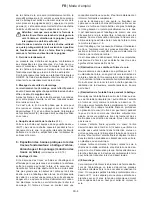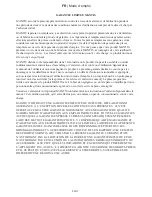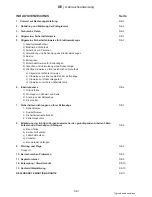
GB
|
Operating Instruction
GB-7
switch-on mechanism and does not need to be
pressed again after the device is switched on.
• To switch off the device, release switch 9.
Attention: The sawing chain will start running
at high speed immediately. When putting the
saw down, make sure that the chain never gets
in touch with stones or metal objects.
Warning!
The prolonged utilisation of a tool will subject the user
to vibration and shocks that could lead to Raynaud‘s
syndrome or Carpal tunnel syndrome.
This condition reduces the ability of the hand to sense
and regulate temperature, causes numbness and a sen-
sation of heat and can lead to damage to the nervous
system and the circulatory system and to necrosis.
Not all factors that lead to Raynaud‘s syndrome are
known but cold water, smoking and illnesses that impact
the blood vessels and the circulatory system as well as
severe or long-lasting exposure to vibrations are known
to be factors in the development of Raynaud‘s syndro-
me. Observe the following in order to reduce the risk of
Raynaud‘s syndrome and Carpal tunnel syndrome:
• Wear gloves and keep your hands warm.
• Make sure the device is well maintained. A tool with
loose components or with damaged or worn-out
dampers will have a disposition towards increased
vibrations.
• Always hold the handle firmly but do not clutch it
constantly with excessive force. Take breaks often.
All of the above precautions cannot exclude the risk of
Raynaud‘s syndrome or Carpal tunnel syndrome. There-
fore, with long-term or regular use it is advisable to keep
a close watch on the condition of your hands and fingers.
Seek medical attention immediately in the event of any
of the above symptoms appearing.
7. Safety devices on your chain brake
1. Chain brake
(Fig. 7)
This chain saw is equipped with a mechanical brake
for the chain. In the case of uncontrolled movements,
when the tip of the sax blade gets in contact with wood
or a solid object, the drive of the chain is immediately
stopped by activation of the hand guard 4, the motor will
not be stopped. This brake function is initiated by the
back of your hand on the front handle 2 pushing the hand
guard. The proper function of the saw chain brake shall
be checked before each use of the saw.
CAUTION: No buttons should be pressed when
the chain brake is released (hand protection
pulled back in the direction of the handle and
locked).
Always ensure before starting the chainsaw that the
hand protection 4 is locked in the operating position.
To do this, pull back the hand protection in the direc-
tion of the handle.
2. Rundown brake
In accordance with the latest regulations, this chain saw
is equipped with a mechanical rundown brake. This
brake is connected to the chain brake and stops the
running chain after the chain saw has been switched off.
It is activated by releasing the ON/OFF switch. The
rundown brake avoids injuries through the coasting of
the chain.
3. Safety starting lock
The starting delay that is effective for about 3 sec. after
each switch-off of the chain saw provides for additional
safety.
Thus, for your own safety, there is a delay of 3 seconds
before the device can be switched on again after each
time it is switched off.
Only after this phase, the saw may be operated again by
pushing the locking button 15 and subsequently activat-
ing the operating switch 9, as described in the section
‘Switching on’.
4. Chain catch bolt
(Fig. 8)
This chainsaw is fitted with a chain catch bolt (17). If the
chain breaks when the saw is in operation, the chain bolt
will catch the loose chain end and thus prevent injury to
the operator‘s hand.
8. Instructions on working properly with the
chain saw
(Fig. 9 - 15)
a) Felling a Tree
When bucking and felling operations are being per-
formed by two or more persons, at the same time, the
felling operation should be separated from the bucking
operation by a distance of at least twice the height of the
tree being felled. Trees should be felled in a manner that
would endanger any person, strike any utility line, the util-
ity company should be notified immediately.
The chain saw operator should keep on the uphill side
of the terrain as the tree is likely to roll or slide downhill
after it is felled.
A retreat path should be planned and cleared as neces-
sary befor cuts are started. The retreat path should ex-
tend back and diagonally to the rear of the expected line
of fall as illustrated in Figure 9.
Before felling is started, consider the natural lean of the
tree, the location of larger branches and the wind direc-
tion to judge which way the tree will fall.
Remove dirt, stones, loose bark, nails, staples, and wire
from the tree where felling cuts are to be made.
b) Notching Undercut
Make the notch 1/3 the diameter of the tree, perpendicu-
lar to the direction of fall as illustrated in 10. Make the
lower horiziontal notching cut first. This will help to avoid
pinching of either the saw chain or the guide bar when
the second notch is being made.
c) Felling Back Cut
Make the felling back cut at least 2 inches (50.8 mm)
higher than the horizontal notching cut as illustrated in
Figure 10. Keep the felling back cut parallel to the hori-
zontal notching cut. Make the felling back cut so enough















































